Jacobsville Sandstone
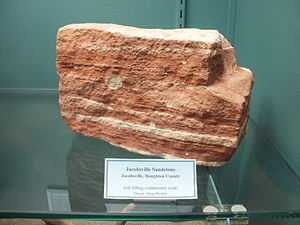
Jacobsville Sandstone is a red sandstone formation, marked with light-colored streaks and spots, primarily found in northern Upper Michigan, portions of Ontario, and under much of Lake Superior. Desired for its durability and aesthetics, the sandstone was used as an architectural building stone both locally and around the United States. The stone was extracted by thirty-two quarries throughout the Upper Peninsula approximately between 1870 and 1915.
The sandstone has been variously called redstone, brownstone, Lake Superior Sandstone, and Eastern Sandstone. In 1907, the Jacobsville Formation was given its current classification and the name Jacobsville, in honor of Jacobsville, Michigan, a town known for its production of the sandstone. There is disagreement regarding the age of the sandstone, though it dates to sometime between the Mesoproterozoic Era and the Middle Cambrian. The formation is of terrestrial origin and is entirely devoid of fossils.
Geology
Classification
The earliest geologic studies of southern Lake Superior were made in the early 1800s. Many studies used the term Lake Superior Sandstone to describe a number of different geologic formations.[1][2] Differentiation of the sandstone largely centered on an east-west division across the Keweenaw Peninsula or between the lower red and upper grey sandstones.[3] The current definition for the Jacobsville Formation was made in 1907 by A. C. Lane and A. E. Seaman, in which the various Lake Superior sandstones were divided into the Jacobsville, Freda, and Munising.[4][5] The Jacobsville reflects the sandstones described as either lower red or Eastern.[6] They also introduced the name Jacobsville in honor of Jacobsville, Michigan, a town notable for its production of the sandstone including the "famous Portage Redstone".[2][6]
Similarities in lithology and heavy mineral suites between the Jacobsville Sandstone and the Bayfield group, a similar sandstone located in northern Wisconsin, suggest they may be correlated.[7][8] Jacobsville Sandstone is most similar to the group's uppermost formation, the Chequamegon Sandstone.[9] Despite their similarities, it is unknown as to whether the two formations are one and the same.[9][10] A correlation between the Jacobsville and the Freda Sandstone (instead of the Bayfield) has been suggested on the basis on similar mineralogy, texture, and stratigraphic position.[11] The formation is similar to the Middle Run Formation in southwestern Ohio.[12] Early studies also suggested a correlation between the Jacobsville and the Potsdam Sandstone in New York.[4]
A red clastic layer in Putnam County, Ohio, was tentatively termed Jacobsville Sandstone in 1948 by Charles Fettke.[12]
Description
Jacobsville Sandstone is generally red, due to small quantities of iron oxides, mottled with various pinks, whites and browns.[13] The sandstone exhibits many white streaks and spherical spots, caused by leaching and bleaching, which form sharp boundaries with surrounding colors.[13][14] Its lithology varies from quartz-rich to feldspar-rich sandstone and shale.[15][16] The formation consists of four distinct facies: conglomerate, lenticular sandstone, massive sandstone, and red siltstone.[17]
The sandstone is well-cemented[16] and contains no glacial deposits and no fossils.[18] The grains of Jacobsville Sandstone range from .25 to .5 mm (0.0098 to 0.0197 in) in size.[13] Based on an average from samples taken in Marquette and Alger counties, Jacobsville Sandstone is composed of: 27.4% nonundulatory quartz, 27.0% undulatory quartz, 23.0% potassium feldspar, and 12.3% silicic volcanic clasts. Smaller constituents are 3.8% polycrystalline quartz, 2.4% metamorphic, 1.4% sedimentary, 1.3% opaque, 0.8% mafic volcanic, and 0.1% plagioclase. Jacobsville Sandstone's heavy mineral suite is 84% ilmenite, 4–5% leucoxene, 4% garnet, 3% apatite, 3% zircon, and 1% tourmaline.[13]
Extent and stratigraphy
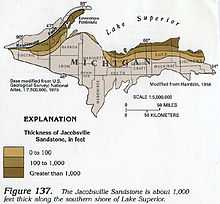
The formation lies southeast of the Keweenaw Fault in the Keweenaw Peninsula, and south of Lake Superior further east in the Upper Peninsula.[19] In Ontario, Jacobsville Sandstone underlies Sault Ste. Marie and extends discontinuously along the lake shore from Bar River in the south to near Wawa in the north.[20][21] The formation also has a small extent in Iron County, Wisconsin.[22] Due to the highly irregular surface on which it was deposited,[8] the formation varies in thickness from 5 ft (1.5 m) to over 1,800 ft (550 m) in Michigan.[23] The sandstone also underlies most of Lake Superior, west of Munising in particular,[6] at a maximum thickness of over 3,000 ft (910 m).[2] The Jacobsville Formation lies unconformably beneath the Munising Formation and above the Oronto Group.[18][24] The formation is an upper member of the Keweenawan Supergroup.[25] Jacobsville Sandstone varies from horizontal to gently inclined and paleocurrents point toward the Lake Superior basin.[26]
The Jacobsville Formation outcrops significantly throughout the Upper Peninsula, with lesser exposures in Ontario and Wisconsin.[27] Cliffs of the sandstone tend to have blocky talus that supports little vegetation.[28] Jacobsville Sandstone, rising only a few feet above lake level, is the oldest formation exposed in Pictured Rocks National Lakeshore. The sandstone features prominently on Grand Island in Hiawatha National Forest.[24]
Formation and age
Jacobsville Sandstone originated in fluvial, lacustrine, and deltaic environments.[24][29] Sand and gravel were transported in streams that flowed northward out of the Northern Michigan Highlands, remnants of mountains formed during the Penokean orogeny. The streams leveled out along what is now the southern shore of Lake Superior, depositing sediment that formed the Jacobsville Sandstone.[8] The environment of deposition was moist and humid, resulting in the sandstone's red color due to the alteration of iron-bearing minerals. Further alteration before the deposition of the Munising Formation created the bands of color in the Jacobsville.[30]
Estimates for the age of the formation range from the late Mesoproterozoic Era (about 1.03 to 1.07 billion years ago)[15] to Middle Cambrian,[31][32] though early geologists believed that it may have dated from as recently as the Upper Cambrian.[33] The age is constrained from 1100 to 540 million years ago as the Jacobsville Formation is bounded above and below by the Munising Formation and the Oronto Group, respectively. However, the age of the sandstone has been difficult to determine.[18] The terrestrial (i.e. non-marine) origin of the Jacobsville means that it contains no fossils[33] with which to date the formation and paleocurrent direction cannot be used to determine its age.[34] Additionally, it contains no igneous intrusions to place a lower bound on age, it provides no paleomagnetic data,[18] and few exposures of the sandstone show its stratigraphic relationship to other formations.[33] Because the Jacobsville Formation fills a portion of the rift that formed Lake Superior, it is generally assigned a late Precambrian age in the United States. This constraint is not present in Canada, so the formation is considered to be of Cambrian age there.[18]
A study in 2010 suggested a likely time of formation at 940 to 910 million years ago.[35] As the Jacobsville formation contains no glacial deposits, it could not have formed during a Snowball Earth event, thus eliminating most of the recent half of the Neoproterozoic Era (approximately 760 to 542 million years ago).[18] In addition, as the overlying and similarly-formed Munising Formation contains a number of fossils while the Jacobsville Formation does not, it is likely that the Jacobsville predates the evolution of macroscopic life at about 800 million years ago.[9] However, further refinement of the period from 1000 to 800 million years ago remains uncertain.[36]
Aquifer
The formation is a mostly unconfined aquifer,[37] called the Jacobsville aquifer,[16] that covers an area of 4,363 square miles (11,300 km2).[38] Despite being a sandstone aquifer, it has a low permeability[39] and water largely moves through cracks and fissures which extend to a depth of about 100 to 150 ft (30 to 46 m). In 1985, 6.5 million US gallons (25,000 m3) of freshwater were withdrawn per day for human use.[16] A number of bedrock wells in the Jacobsville aquifer have elevated levels of uranium.[40] The elevated uranium also contributes to high radon levels, particularly in the Keweenaw Peninsula.[41]
Extraction
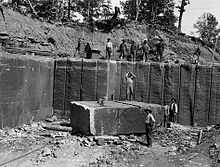
The earliest extraction of the sandstone occurred in Alger County in the 1860s with two companies providing stone to build nearby blast furnaces for the iron industry.[42] The first widespread and commercial quarrying of the sandstone began around 1870.[43] The industry peaked in the early 1890s.[44] About thirty-two quarries[45] existed over the years, clustered near Jacobsville and Marquette with others scattered along the Lake Superior coast.[46] The end of the industry occurred variably by location, though finishing around 1915 at the outbreak of World War I.[47]
One of the principal figures in the Jacobsville Sandstone industry was John Henry Jacobs,[45] to whom the largest producers in the Jacobsville area were associated.[48] The town was founded in 1884 when Jacobs opened his first quarries in the area.[49] Both the sandstone and the town of Jacobsville are named for him.[19]
The two main varieties of Jacobsville Sandstone that were quarried were redstone and brownstone.[50] Redstone came from the Jacobsville area, in both uniform and variegated varieties.[51] A purplish-brown variety of brownstone known as rain-drop, so named for its wet appearance, was described as the "most handsome stone quarried on Lake Superior."[52] Brownstone and rain-drop were supplied from Marquette, however, supplies were generally limited.[51] Until the early 1900s, Jacobsville Sandstone was popularly known as Lake Superior Sandstone, brownstone or redstone and prefixed by the location in which it was quarried, such as Marquette and Portage Entry (e.g., Marquette brownstone).[8]
Technique
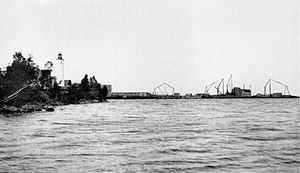
The sandstone was quarried as dimension stone, ton stone, and rubble stone, with dimension stone the most marketable and costly. Blocks of dimension stone typically measured 8 by 4 by 2 ft (2.44 by 1.22 by 0.61 m).[53] The byproduct of removing the dimension stone was rubble stone, which was either sold cheaply or discarded entirely.[54] The sandstone was extracted between April and November,[55] as winter could be detrimental to the stone.[56]
When a new quarry was opened, up to 50 ft (15 m) of glacial drift and shale overburden was blasted and removed to access the sandstone beneath. If no cliffs of sandstone existed for a quarry face, long and narrow channels spaced four feet apart were cut to allow quarrying.[55] A key was removed from between the channels, either by wedging or blasting, to create a space for blocks to move to as they were removed.[57] Once the key was removed, holes were drilled horizontally under the block to be quarried and then cracked open with wedges. These large blocks were then broken down to size with wedges struck by sledgehammers. Once properly sized, the blocks were either transported by tramcar to docks or directly loaded onto ships.[58] From there the sandstone was shipped to ports along the Great Lakes for distribution inland.[51][56]
Decline
| Year | Total value[59] |
|---|---|
| 1899 | $178,038 |
| 1900 | $132,650 |
| 1901 | $174,428 |
| 1902 | $188,073 |
| 1903 | $121,350 |
| 1904 | $74,868 |
| 1905 | $123,123 |
| 1906 | $65,395 |
| 1907 | $53,003 |
| 1908 | $39,103 |
| 1909 | $36,084 |
| 1910 | $31,233 |
| 1911 | $12,985 |
| 1912 | $16,438 |
| 1913 | $19,224 |
| 1914–1916 | — |
The World's Columbian Exposition of 1893 in Chicago, with its White City, ushered in a change of style that preferred light-colored marbles and limestones over the dark color of Jacobsville Sandstone.[60] The direction of architecture was dramatically altered within a decade at the expense of Jacobsville Sandstone, especially in the Lake Superior region.[61] In 1896, the commissioner of mineral statistics for Michigan reported that:
Architects have pronounced against it in their plans and specifications ... for the reason that architecture must have a change of style and material the same as millinery and tailoring. They claimed that too much sandstone was being used, and that the sameness must be broken into by the use of stone of other kind and color...[56]
The industry began to decline and many quarries idled as previously mined sandstone was sufficient to meet demand.[62] After several years of depressed demand, the industry rebounded around the turn of the century.[50] However, Michigan's total output of sandstone peaked in 1902 at a value of $188,073 and fell to $12,985 by 1911.[59] By 1914, fewer than three companies were producing sandstone in the state and thus no figures were recorded.[59]
According to the director of the Michigan Geological and Biological Survey, the decline was caused in part by the Depression of 1893 and the large distance from the quarries to major markets.[62] Artificial stone, concrete, and brick had become popular and inexpensive, displacing all varieties of stone from the market.[62] In addition, brick manufacturers successfully campaigned against the use of stone.[63] Around 1897, Jacobsville Sandstone attracted attention during the construction of the Wayne County Courthouse.[64] Use of the sandstone was contracted but eventually rescinded, in favor of stone from Ohio,[65] amid accusations that Jacobsville Sandstone was of inferior strength and durability.[64]
The exact end of the industry is unclear, but most quarries were closed by about 1915.[45] Records indicate that the last active quarry, operated by the Portage Entry Redstone Company, closed between 1923 and 1926.[51] Despite the demise of the industry, some new construction still used Jacobsville Sandstone several years into the twentieth century. Examples include the Baraga School (1903–06), J H Kaye Hall (1913–15) at Northern State Normal School (now Northern Michigan University), and a statue named the USS Kearsarge constructed in Wolverine by the Works Progress Administration.[66] As most of the quarries were no longer in operation, the sandstone was often salvaged from existing buildings.[67]
The town of Jacobsville, founded by the sandstone industry, peaked in population around 1897 at about 800 residents.[49] The town began declining around 1910 and by the mid-1960s, the post office had closed and only seventy inhabitants remained.[68]
Other resources and future
Though Jacobsville Sandstone was primarily used as stone, there exists the potential for other industries. The formation contains a large amount of iron, but there has been little exploration.[34] There has been a history of exploration for uranium resources in the Upper Peninsula, including within the Jacobsville formation.[69][70] Between 2003 and 2010, a joint operation between two companies spent $1.6 million on uranium exploration in the Jacobsville.[71] There has also been some interest in resuming extraction of the sandstone as dimension stone.[72]
Uses
Material qualities
Jacobsville Sandstone was popular as a building material because of its strength, durability and aesthetic appeal. In particular, it is resistant to the extremes in temperature of fire and the freeze-thaw cycle of northern climates.[73] The Mining Journal of Marquette reported on November 20, 1875, that:
Its fire-proof qualities were thoroughly tested in the great Chicago fire, where Lake Superior brownstone walls...stood intact, without a crack, scale or blemish being caused by the great heat under the influence of which marble fronts crumbled and fell to the ground.[74]
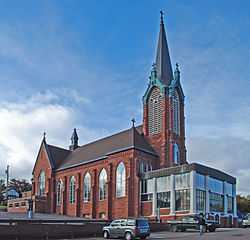
The sandstone was inexpensively obtainable in large quantities and transport by the Great Lakes further reduced costs. It is also easily worked and carved, and could be used throughout a building.[43] The most desired stone was without white blemishes and with uniform coloring.[55] The Richardsonian Romanesque style, which is "particularly suited for expression in colored stone", helped to popularize the sandstone in architecture.[62] Buildings of this style created the impression of stability in a fast-changing society and were well-suited to the character of the Lake Superior region.[75]
Buildings and structures
Several buildings in the Upper Peninsula[76] and across the United States incorporate Jacobsville Sandstone in their construction. In the Upper Peninsula, these buildings include The Calumet Theatre,[77] Saint Ignatius Loyola Church,[78] and several buildings in the Quincy Street Historic District.[79] Elsewhere, the sandstone was used in the original Waldorf-Astoria Hotel in New York City.[49]
The rubble stone was commonly used for foundations, cribs, breakwaters and piers.[54]
Jacobsville Sandstone has been used as concrete aggregate[51] and flagstone.[80]
See also
Notes
- ↑ Hamblin 1958, p. 5
- ↑ 2.0 2.1 2.2 "The Jacobsville Formation and Associated Units in Ontario" (PDF). Ontario Ministry of Northern Development and Mines. February 12, 1987. Archived from the original on December 18, 2012. Retrieved February 16, 2012.
- ↑ Hamblin 1958, pp. 5–6
- ↑ 4.0 4.1 Hamblin 1958, p. 6
- ↑ Lane, A.C.; Seaman, A.E. (1907). "Notes on the Geological Section of Michigan: Part I. The Pre-Ordovician". The Journal of geology (University of Chicago Press) 15: 692. Bibcode:1907JG.....15..680L. doi:10.1086/621460.
- ↑ 6.0 6.1 6.2 Hamblin 1958, p. 9
- ↑ Hamblin 1958, p. 7
- ↑ 8.0 8.1 8.2 8.3 Eckert 2000, p. 33
- ↑ 9.0 9.1 9.2 Baumann 2010, p. 6
- ↑ Bulletin, Issue 25. Wisconsin Geological and Natural History Survey. 1912. p. 104.
- ↑ Ostrom, Meredith E. "Paleozoic Stratigraphic Nomenclature For Wisconsin" (PDF). Information Circular Number 8. The University of Wisconsin Geological and Natural History Survey. Retrieved April 5, 2012.
- ↑ 12.0 12.1 Shrake, Douglas L. (1991). "The Middle Run Formation: A Subsurface Stratigraphic Unit in Southwestern Ohio" (PDF). The Ohio Journal of Science (The Ohio Academy of Science) 91 (1): 51. Retrieved May 4, 2012.
- ↑ 13.0 13.1 13.2 13.3 Eckert 2000, p. 34
- ↑ Hamblin 1958, pp. 11–12
- ↑ 15.0 15.1 James St. John. "Jacobsville sandstone". Ohio State University. Retrieved September 22, 2012.
- ↑ 16.0 16.1 16.2 16.3 Olcott, Perry G. "Jacobsville and Crystalline-Rock Aquifers". Ground Water Atlas of the United States: Iowa, Michigan, Minnesota, Wisconsin. United States Geological Survey. Archived from the original on September 22, 2012. Retrieved August 12, 2011.
- ↑ Hamblin 1958, pp. 12–19
- ↑ 18.0 18.1 18.2 18.3 18.4 18.5 Baumann 2010, p. 5
- ↑ 19.0 19.1 Eckert 2000, p. 31
- ↑ Atkinson et al. 2007, p. 11
- ↑ Wood et al. 1982, p. 113
- ↑ Olcott, Perry G. "Regional Summary". Ground Water Atlas of the United States: Iowa, Michigan, Minnesota, Wisconsin. United States Geological Survey. Archived from the original on September 22, 2012. Retrieved April 22, 2012.
- ↑ Hamblin 1958, pp. 9–10
- ↑ 24.0 24.1 24.2 "Pictured Rocks: Geologic Formations". US National Park Service. Archived from the original on September 22, 2012. Retrieved August 5, 2011.
- ↑ "Digital Bedrock Geologic Map of the Ashland and Northern Part of the Ironwood 30' x 60' Quadrangles, Wisconsin and Michigan: Background" (PDF). United States Geological Survey. 1999. p. 3. Retrieved June 8, 2012.
- ↑ Atkinson et al. 2007, p. 12
- ↑ Baumann 2010, p. 3
- ↑ "Sandstone Lakeshore Cliff" (PDF). Michigan Natural Features Inventory. Michigan State University. p. 5. Retrieved April 21, 2012.
- ↑ Sherman et al. 2003, p. 2
- ↑ Rose 1997, p. 1
- ↑ "Geologic Unit: Jacobsville". United States Geological Survey. Retrieved September 28, 2011.
- ↑ Dorr, John Adam; Eschman, Donald F. (1970). Geology of Michigan. University of Michigan Press. p. 91. ISBN 978-0-472-08280-3.
- ↑ 33.0 33.1 33.2 Hamblin 1958, p. 24
- ↑ 34.0 34.1 Baumann 2010, p. 2
- ↑ Baumann 2010, p. 7
- ↑ Baumann 2010, pp. 6–7
- ↑ "Sandstone acquifers". Groundwater Atlas of the United States. USGS. Retrieved 30 November 2014.
- ↑ "List of Acquifers" (PDF). Advisory Committee on Water Information. Retrieved October 30, 2011.
- ↑ Vanlier, Kenneth E. (1963). "Water Investigation 1: Reconnaissance of the Ground-Water Resources of Alger County, Michigan" (PDF). Michigan Department of Environmental Quality. p. 11. Retrieved August 31, 2011.
- ↑ Sherman et al. 2003, p. 10
- ↑ Hauglie, Kurt (October 18, 2010). "Taking a dangerous breath". The Daily Mining Gazette. Retrieved April 29, 2012.
- ↑ H. James Bourque and Associates 1999, p. 49
- ↑ 43.0 43.1 Eckert 2000, p. 49
- ↑ Eckert 2000, p. 50
- ↑ 45.0 45.1 45.2 H. James Bourque and Associates 1999, p. 5
- ↑ Eckert 2000, p. 51
- ↑ H. James Bourque and Associates 1999, p. 56
- ↑ Eckert 2000, p. 70
- ↑ 49.0 49.1 49.2 Staff. "Jacobsville Finnish Lutheran Church". State Historic Preservation Office. Michigan State Housing Development Authority. Retrieved February 19, 2011.
- ↑ 50.0 50.1 Russel, James (1900). State of Michigan: Mines and Mineral Statistics (PDF) (Report). State of Michigan. p. 11. Archived from the original on September 22, 2012. Retrieved April 5, 2012.
- ↑ 51.0 51.1 51.2 51.3 51.4 Heinrich, E. William (2001). Report of Investigation 21: Economic Geology of the Sand and Sandstone Resources of Michigan (PDF) (Report). Michigan Department of Environmental Quality, Geological Survey Division. p. 7. Archived from the original on September 22, 2012. Retrieved November 4, 2011.
- ↑ Eckert 2000, p. 54
- ↑ Eckert 2000, p. 40
- ↑ 54.0 54.1 Eckert 2000, p. 41
- ↑ 55.0 55.1 55.2 Eckert 2000, p. 42
- ↑ 56.0 56.1 56.2 Newett, George A. (1896). State of Michigan: Mines and Mineral Statistics (PDF) (Report). State of Michigan. p. 78. Retrieved April 4, 2012.
- ↑ Eckert 2000, p. 43
- ↑ Eckert 2000, p. 45
- ↑ 59.0 59.1 59.2 Mineral resources of Michigan with statistical tables of production and value of mineral products for 1916 and prior years (Report) (20). Michigan Geological Survey, United States Bureau of Mines. 1917. p. 191.
- ↑ Eckert 2000, p. 28
- ↑ Eckert 2000, pp. 27–28
- ↑ 62.0 62.1 62.2 62.3 Eckert 2000, p. 86
- ↑ Eckert 2000, p. 87
- ↑ 64.0 64.1 Newett, George A. (1897). State of Michigan: Mines and Mineral Statistics (PDF) (Report). State of Michigan. p. 78. Archived from the original on September 22, 2012. Retrieved May 3, 2012.
- ↑ Staff. "Wayne County Courthouse". State Historic Preservation Office. Michigan State Housing Development Authority. Retrieved May 3, 2012.
- ↑ Eckert 2000, pp. 28–29
- ↑ Eckert 2000, p. 29
- ↑ Holmio, Armas Kustaa Ensio (2001). History of the Finns in Michigan. Wayne State University Press. p. 95. ISBN 978-0-8143-2974-0.
- ↑ Sherman, Heidi M. (2004). "Hydrogeochemcial Controls on Uranium in Aquifers of the Jacobsville Sandstone" (PDF). Michigan Technological University. p. 14. Retrieved April 24, 2012.
- ↑ Staff (March 31, 1982). Uranium in Michigan: Report to the Governor (PDF) (Report). Michigan Department of Natural Resources and Department of Public Health. p. 20–22. Archived from the original on September 22, 2012. Retrieved April 23, 2012.
- ↑ "Upper Peninsula Uranium Exploration Overview". Bitterroot Resources Ltd. January 8, 2010. Archived from the original on September 21, 2012. Retrieved April 24, 2012.
- ↑ H. James Bourque and Associates 1999, p. 6
- ↑ Eckert 2000, p. 48
- ↑ Eckert 2000, pp. 49–50
- ↑ Eckert 2000, p. 27
- ↑ "Rock Types and Rock Structure of the UP". Michigan State University. Archived from the original on September 22, 2012. Retrieved August 12, 2011.
- ↑ Dunlop, Joan (12 May 1991). "Pines, mines, llamas and pasties on Michigan's Keweenaw Peninsula". Chicago Sun-Times. Retrieved August 12, 2011.
- ↑ Staff. "Saint Ignatius Loyola Church". State Historic Preservation Office. Michigan State Housing Development Authority. Retrieved August 21, 2011.
- ↑ Staff. "Quincy Street Historic District". State Historic Preservation Office. Michigan State Housing Development Authority. Archived from the original on September 22, 2012. Retrieved August 12, 2011.
- ↑ Kirkby, Edward A. (1964). "Michigan Sandstones". Bulletin 1: Our rock riches: a selected collection of reprinted articles on Michigan's mineral resources (PDF) (Report). State of Michigan, Department of Conservation, Geological Survey. p. 36. Archived from the original on September 22, 2012. Retrieved February 16, 2015.
References
- Atkinson, B. T.; Hailstone, M.; Wilson, A. C.; Draper, D. M.; Pace, A.; Woo, H. (2007). Timmins Regional Resident Geologist Report: Timmins and Sault Ste. Marie Districts (PDF) (Report). Ontario Geological Survey. Retrieved August 1, 2012.
- Baumann, Steven D.J. (2010). Lithostratigraphy and Age of Jacobsville Formation around the Lake Superior Basin, U.S.A. and Canada (PDF) (Report). Midwest Institute of Geosciences and Engineering. Retrieved February 19, 2012.
- Eckert, Kathryn Bishop (2000). The sandstone architecture of the Lake Superior region. Wayne State University Press. ISBN 978-0-8143-2807-1.
- H. James Bourque and Associates (July 1, 1999). "Dimension Stone Feasibility Study" (PDF). Michigan Department of Environmental Quality. Retrieved August 28, 2011.
- Hamblin, W.M. Kenneth (1958). The Cambrian Sandstones of Northern Michigan (PDF) (Report). State of Michigan Department of Conservation, Geological Survey Division. pp. 2–18. Archived from the original on February 13, 2013. Retrieved February 16, 2012.
- Hamblin, W.M. Kenneth (1958). The Cambrian Sandstones of Northern Michigan (PDF) (Report). State of Michigan Department of Conservation, Geological Survey Division. pp. 19–37. Archived from the original on February 13, 2013. Retrieved February 16, 2012.
- Hamblin, W.M. Kenneth (1958). The Cambrian Sandstones of Northern Michigan (PDF) (Report). State of Michigan Department of Conservation, Geological Survey Division. pp. 38–55. Archived from the original on February 13, 2013. Retrieved February 16, 2012.
- Rose, Robert (1997). Overview of Cambrian Sandstone Environments of Deposition (PDF). Pictured Rocks National Lakeshore Resource Report (Report) (US National Park Service). Retrieved July 11, 2012.
- Sherman, Heidi M.; Taylor, Peter; Gierke, John S.; Anderson, Cecilia P. (2003). Elevated Uranium in Aquifers of the Jacobsville Sandstone, Upper Peninsula, Michigan, USA (PDF) (Report). National Ground Water Association. p. 11. Retrieved April 23, 2012.
- Wood, John; White, Owen L.; Barlow, R. B.; Colvine, A. C. (1982). Summary of Field Work, 1982 (PDF) (Report). Ontario Geological Survey. Retrieved August 1, 2012.
External links
| Wikimedia Commons has media related to Jacobsville Sandstone. |
- Map showing extent of Jacobsville Sandstone in Ontario, from the Ontario Ministry of Northern Development and Mines
- Quarry images at cityofhoughton.com
- Portage Houghton Quarry